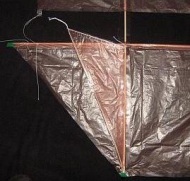- Home Page
- Better Kites
- ... Dopero Kite
How to Make a Dopero Kite
Step by Step—Page 3 of 4
How to Make a Dopero Kite
Keels
Dacron line in 50-pound strength is ideal for these Dowel Series kites.

- Mark out the keel shape on some spare plastic as per the dimensions on the template.
- Cut out the keel, and tape down two lengths of flying line onto one side. One goes from the bridle attachment point to the upper attachment point, and the other goes from the bridle attachment point to the lower attachment point. Use sticky tape, not electrical tape. The pieces of line hanging free should be at least as long as your finger.
- Now flip the plastic over, and tape down another two lengths of flying line directly over the first two.
- Where two pieces of line come together, tie a Multi-Strand Simple knot close to the plastic. These two knots will sit against the vertical spar. See the top left photo.
- Where the four pieces of line come together, tie a Multi-Strand Simple knot close to the plastic, then tie another one further out as in the top right photo. The bottom photo shows the complete keel.
- Reinforce the keel with short lengths of sticky tape, where indicated by the yellow rectangles.
- This kite has two such keels, so now do it all again to make the second keel.
Have a good look at the photo down there, which shows one of the keels in place. Follow the instructions to do that one, then do it all again on the other side for the second keel.

- Cut a slit in the plastic sail between the two long vertical pieces of tape. The slit should go all the way from the edge of the insulation tape spar cap up to the lower horizontal spar.
- Pass the lower keel lines through the slit in the lower sail. Now tightly tie them around the vertical spar using a Granny knot. Get the knot as close to the tip of the dowel as you can.
- Using the keel itself to find the exact spot, tightly tie the upper lines around the dowel also. This will be quite close to where the lower horizontal spar crosses the vertical spar.
- Fold the 4-dowel-width tab around the dowel, and tape it down all along its length with a piece of clear sticky tape.
- Put a drop of wood glue all over the two knots and all around the dowel where the keel lines touch the wood.
How to Make a Dopero Kite
Bridle

- Cut off some 50-pound flying line to a length of 1.0 DL (120 cm, 48 in.), and tie a very small Loop knot into each end.
- Poke holes in the plastic on either side of the upper horizontal spar. There's four holes altogether, 0.24 DL (28.8 cm, 11 1/2 in.) from the centerline of the sail, as indicated by the four yellow dots in the photo.
- Tie each end of the line to the spar through the holes. Use a Double Wrap Slip knot, and pull tight against the knot of the small loop. This is the upper bridle loop.
- Do another bridle loop just the same, except make the loop knots bigger, since they will be used for Lark's Head knots. This is the lower bridle loop.
- Cut off some flying line to a length of 2.0 DL (240 cm, 96 in.). Attach one end to the upper bridle loop and the other end to the lower bridle loop. Use a shiftable knot such as the Prusik knot, and adjust it to center on both bridle loops. Let's just call this the bridle line.
Before the first flight, the two loop knots of the lower bridle loop will get attached to the free tip of each keel using a Lark's Head knot.
Finally, take a length of flying line about 0.2 DL (24 cm, 10 in.) long, and tie one end to the bridle line with a Prusik knot. Tie a small Double Loop knot into the other end just to get a large knot. There's a photo of this on the next page in the section titled Prepare To Fly.
At this point, you've pretty much finished making the Dowel Dopero!
As mentioned earlier, there's more kite making on this site than you can poke a stick at. :-)
Want to know the most convenient way of using it all?
The Big MBK E-book Bundle is a collection of downloads—printable PDF files which provide step-by-step instructions for many kites large and small.
That's every kite in every MBK series.
